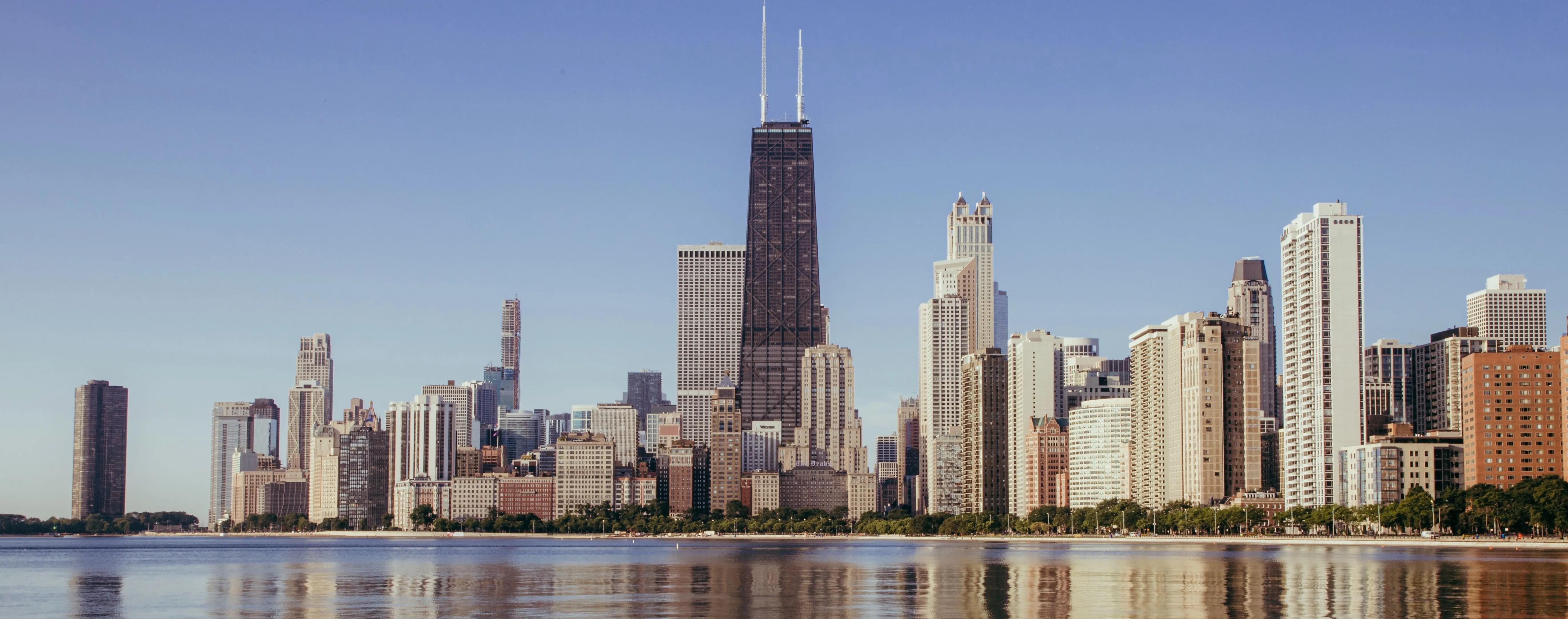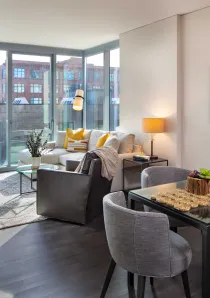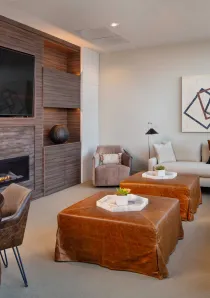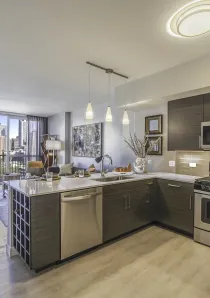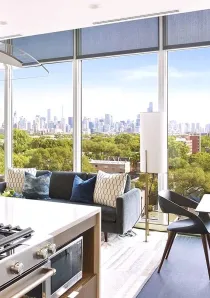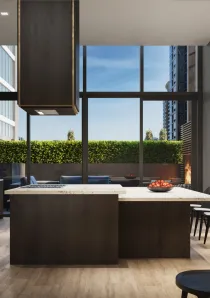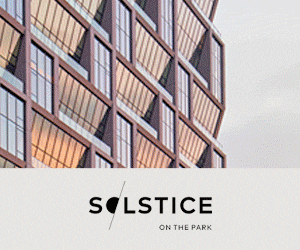The Complete Guide to High Rise Living in Chicago
Chicago high-rise apartments offer an unmatched living experience for renters seeking breathtaking views, modern amenities, and direct access to the heart of the city. Rising 12 to over 100 stories, these iconic buildings define Chicago’s skyline, offering panoramic vistas of Lake Michigan, downtown, and beyond. Renting a high-rise apartment in Chicago places you steps away from world-class shopping, dining, and cultural landmarks like Navy Pier and Millennium Park.
This comprehensive guide will explore everything you need to know about high-rise apartments in Chicago — from choosing the best neighborhoods like Streeterville and River North, to understanding different building classes (A, B, and C), to breaking down costs and highlighting top amenities such as rooftop pools, fitness centers, and pet-friendly facilities. Whether you're looking for luxury skyscrapers like NEMA or a more budget-friendly high-rise near the lakefront, Chicago’s vertical communities offer options for every lifestyle and budget.
Start your journey toward elevated city living with this definitive guide to high-rise apartment rentals in Chicago.
What Are High-Rise Apartments?
Chicago high-rise apartments are within buildings that are at least 12 stories high, with many reaching 40, 50, or even 100 floors. They're the structures that give Chicago its jaw-dropping skyline and residents a broad view of Lake Michigan, downtown, and beyond.
One of the biggest perks of living in a high-rise apartment is the amenities. Many are like mini-cities, with gyms, pools, social lounges, cafes and restaurants, and even grocery stores. Whether you hate walking through the city in your workout clothes or want rooftop views of the sunset every evening, high-rise apartments are all about easy living.
When comparing high-rise buildings to other types of rentals, high-rises come out leagues ahead in most regards. Unlike walk-ups, you won't be huffing up staircases. High-speed elevators whisk you from floor to floor, which makes them an especially attractive choice for those with mobility issues. While quaint three-story buildings have their charm, they can't match the convenience (and wow factor) of high-rise living. Mid-rise buildings (5 to 11 stories) try to offer the best of both worlds, but high-rises often surpass them in amenities. There’s also a certain cachet to saying you live on the 30th floor.
Although the " pros " list can get extensive, high-rise living isn't for everyone. They often tend to have smaller floor plans than apartments found on residential side streets, and you won’t get a private yard like you might with a vintage walkup. But for many Chicagoans, the trade-off is worthwhile. Where else can you watch the sun rise over Lake Michigan from your living room while sipping your morning coffee?
To give you an idea of the scale of high-rise living in Chicago, here are some of the largest high-rise apartment buildings in the city:
- NEMA: 800 apartments
- 1000M: 738 apartments
- One Chicago: 667 apartments
- Eugenie Terrace: 575 apartments
- Wolf Point West: 529 apartments
- One Eleven: 504 apartments
- Coast at Lakeshore East: 499 apartments
With so many apartments under one roof, these buildings are often referred to as vertical communities. From chance encounters in the elevator to organized resident events, living in one of these mega-towers offers a unique blend of big-city anonymity and small-town camaraderie. Who knows? Your next best friend might just be a few floors away.
Is Chicago Really the Birthplace of the Skyscraper?
The short answer is: yes, Chicago can rightfully claim to be the birthplace of the modern skyscraper. In 1885, the Home Insurance Building rose to a then-impressive ten stories, using a revolutionary steel-frame construction that would define skyscrapers for generations to come. This innovative approach, developed by architect William Le Baron Jenney, allowed buildings to reach unprecedented heights while maintaining structural integrity. While New York and other cities would eventually surpass Chicago in sheer number of skyscrapers, the Windy City's role as the pioneer of these steel giants is undisputed.
You might think Chicago's obsession with skyscrapers is just about showing off, but there's way more to the story. It all kicked off with the Great Chicago Fire of 1871. Yes, it was a major disaster, but it also gave the city a clean slate to dream big and build bigger. Suddenly, Chicago was like a kid with a brand-new set of LEGO bricks, ready to stack 'em high.
Here's a fun fact: Chicago's squishy clay soil, which sounds like a builder's nightmare, actually helped us reach for the stars. Clever engineers came up with tricks like the "Chicago caisson" (think of it as fancy stilts for skyscrapers) to keep those towers standing tall.
And let's be real, we Chicagoans love a good competition. When New York started flexing its architectural muscles, we rolled up our sleeves and said, "Oh yeah? Watch this." Before you knew it, we were in a full-on skyscraper arms race, pushing the limits of what was possible.
With the best architecture schools pumping out innovative thinkers and big corporations setting up shop, Chicago became a playground for architectural daredevils. We pioneered wind-bracing techniques (because nobody wants their office swaying like a boat) and revolutionized elevator tech (because stairs are so 19th century).
To put Chicago’s prowess into perspective, here are the five tallest buildings in the city:
- Willis Tower (Sears Tower) 1730 ft, 110 floors
- 875 N Michigan (John Hancock) 1500 ft, 100 floors
- Trump Tower 1389 ft, 98 floors
- St Regis Tower 1198 ft, 101 floors
- Aon Center 1136 ft, 83 floors
Although impressive, in the end, it's about more than just tall buildings. It's about Chicago's can-do spirit, our knack for turning challenges into opportunities, and maybe a little bit of that Midwestern "anything you can do, I can do taller" attitude.
Where to Find High-Rise Apartments in Chicago
Chicago’s skyline is adorned with high-rise apartments and condominiums, primarily concentrated along or near the picturesque Lake Michigan shoreline. While favorable zoning laws have allowed for the development of these towering structures from South Shore to Edgewater, certain neighborhoods stand out for their impressive clusters of high-rises:
Streeterville: Right next to downtown, this neighborhood is home to Navy Pier and some of Chicago's tallest residential buildings. It's all about convenience here, as you're just steps away from Michigan Avenue shopping and lakefront trails.
South Loop: Once an industrial area, the South Loop has transformed into a hot spot for new high-rises. It has a great mix of modern towers and converted loft buildings, and you're close to the Museum Campus and Grant Park.
River North: If you're into nightlife and restaurants, River North's your spot. This area north of the Chicago River is packed with trendy eateries, art galleries, and plenty of high-rise apartments.
West Loop and Fulton Market: The former meatpacking district is now Chicago's foodie paradise. It's recently seen a boom in high-rise construction, offering a mix of industrial chic and modern luxury.
Gold Coast: Want old-world charm with your high-rise living? The Gold Coast delivers. This upscale neighborhood has both historic and new high-rises, with easy access to the lakefront and high-end shopping on Oak Street.
Lakeview: A bit further north, Lakeview offers a more laid-back vibe. You'll find high-rises scattered throughout, especially near the lake. It's a great option if you want a neighborhood feel with high-rise perks.
Uptown: This diverse neighborhood is experiencing a renaissance, with several new high-rises popping up. It's known for its entertainment history and beautiful vintage buildings.
Edgewater: At the northern end of Chicago's Lakefront Trail and DuSable Lake Shore Drive, Edgewater offers a quieter high-rise experience. You'll get amazing lake views and access to some of the city's best beaches.
Each of these neighborhoods has its own unique flavor, but they all offer that quintessential Chicago high-rise experience. Whether you're after the hustle and bustle of downtown or a more relaxed lakefront vibe, there's a high-rise neighborhood that'll fit your style. Just remember, the higher you go, the better the view!
Types of High-Rise Apartments
When searching for your perfect high-rise Chicago apartment, you'll encounter three main classifications: Class A, B, and C. Understanding these categories will help you navigate the market and find the best fit for your lifestyle and budget.
Class A High-Rise Chicago Apartments
These apartments represent the pinnacle of luxury living. Typically built within the last decade or extensively renovated, Class A high-rises offer unparalleled amenities and prime locations, often found in the West Loop, South Loop, Lakeshore East, Fulton Market, Streeterville, and Chicago Loop.
Features of Class A high-rise Chicago apartments:
- Cutting-edge smart home technology
- High-end finishes (think marble countertops and hardwood floors)
- Floor-to-ceiling windows with spectacular city or lake views
- State-of-the-art fitness centers, often with personal training services
- Rooftop decks with infinity pools and outdoor entertainment areas
- 24/7 concierge and security services
- On-site restaurants or high-end grocery stores
- Pet spas and dog runs
- Co-working spaces and conference rooms
For more information on renting these luxury apartments, including amenities, costs, and where they can be found, head over to Domus “Luxury Apartments” guide.
Class B High-Rise Chicago Apartments
These buildings offer a sweet spot between luxury and affordability. Typically 15-25 years old, Class B high-rises are well-maintained and provide good amenities without the premium price tag. These can be found in Gold Coast, South Loop, Streeterville, Chicago Loop, and River North.
Features of Class B high-rise Chicago apartments:
- Updated, but not necessarily brand-new appliances
- In-unit laundry in most cases
- Fitness centers with standard equipment
- Comfortable common areas for socializing
- Often located in desirable neighborhoods, slightly off the prime spots
- Professional management and maintenance teams
- Some smart home features, though not as extensive as Class A
Class C High-Rise Chicago Apartments
Don't overlook these affordable high-rise apartments. Chicago Class C high-rises are typically 25+ years old and may show their age, but they often provide unbeatable locations at more budget-friendly prices. You can find well-located Class C buildings along the Lake in South Shore, Hyde Park, Bronzeville, South Loop, Streeterville, Gold Coast, Lincoln Park, Lakeview, Edgewater, and Uptown.
Features of Class C high-rise Chicago apartments
- Basic amenities (laundry facilities, maybe a small fitness room)
- Older appliances and finishes, but functional
- Often in excellent locations, allowing for an urban lifestyle on a budget
- May lack some modern features like central air or in-unit laundry
- Potential for more spacious floor plans due to older designs
- Some offer vintage charm with unique architectural details
When choosing your high-rise Chicago apartment, consider your priorities. If you value cutting-edge amenities and are willing to pay for them, a Class A building might be your best bet. If you're looking for a balance of quality and affordability, explore Class B options. And if location is your top concern and you're comfortable with fewer frills, a Class C high-rise could be the perfect fit.
Remember, these classifications are guidelines, not hard rules. A well-maintained Class C building might offer a better living experience than a poorly managed Class B. Always visit properties in person, read reviews from current tenants, and consider factors like commute time, neighborhood vibe, and long-term value when making your decision.
By understanding these classifications, you're better equipped to find the high-rise Chicago apartment that best suits your needs, lifestyle, and budget.
Costs of Renting High-Rise Apartments
Renting a high-rise apartment in Chicago can be an exciting prospect, but it's essential to understand the costs involved. A common question we get is “How much are high-rise apartments in Chicago?” Let's break down what you can expect to pay and why prices can vary so much across the city.
Price Ranges by Class and Neighborhood
Class A High-Rises
- Downtown/Loop: $2,500 - $5,000+ for a studio, $3,000 - $7,000+ for a one-bedroom
- River North/Streeterville: $2,300 - $4,500 for a studio, $2,800 - $6,000+ for a one-bedroom
- West Loop: $2,200 - $4,000 for a studio, $2,700 - $5,500 for a one-bedroom
Class B High-Rises
- Lakeview/Lincoln Park: $1,400 - $2,200 for a studio, $1,800 - $2,800 for a one-bedroom
- South Loop: $1,500 - $2,500 for a studio, $1,900 - $3,000 for a one-bedroom
- Gold Coast: $1,600 - $2,700 for a studio, $2,000 - $3,500 for a one-bedroom
Class C High-Rises
- Uptown/Edgewater: $900 - $1,400 for a studio, $1,200 - $1,800 for a one-bedroom
- Rogers Park: $850 - $1,300 for a studio, $1,100 - $1,700 for a one-bedroom
- Hyde Park: $1,000 - $1,500 for a studio, $1,300 - $2,000 for a one-bedroom
Keep in mind that these ranges are approximate and can fluctuate based on market conditions and specific building features. Before you start searching, read through our guide on “What Credit Score is Needed to Rent an Apartment” and use Domus Rent Calculator to determine what your income can afford.
Factors Affecting Rent Prices:
- Location: Prime downtown spots or trendy neighborhoods typically command higher rents.
- Views: Units with skyline or lake views often come at a premium.
- Floor Level: Generally, the higher the floor, the higher the rent.
- Amenities: Buildings with extensive amenities like pools, fitness centers, and concierge services usually have higher rents.
- Unit Size and Layout: Larger units or those with unique floor plans may cost more.
- Age and condition of the building: Newer or recently renovated buildings typically charge more.
- Parking: Included parking can significantly increase the overall cost.
- Seasonality: Rents may be higher during peak moving seasons (usually summer months).
- Market Demand: Popular areas with low vacancy rates often have higher rents.
- Utilities: Some high-rises include utilities in the rent, which can affect the overall price.
- Building Policies: Pet-friendly buildings or those allowing short-term leases might charge more.
- Proximity to Public Transit: Units near 'L' stations or major bus routes often command higher rents.
When budgeting for a high-rise apartment in Chicago, don't forget to factor in additional costs like security deposits, move-in fees, and potential assessments for amenities. Some buildings may require renter's insurance as well. Our “Detailed Costs to Rent an Apartment in Chicago” guide breaks down these costs to help you manage your budget.
Amenities and Features
Chicago's high-rise apartments offer way more than just amazing views. They're also packed with perks that can seriously upgrade your living situation. Most buildings have fitness centers, ranging from basic cardio rooms to gyms that'll make your local health club jealous. Laundry's a breeze, with many units featuring in-unit washers and dryers. And in this age of constant deliveries, secure package rooms are a godsend. Bike storage is often available too, perfect for all you city cyclists.
Need some fresh air? Many buildings have perfectly landscaped rooftop decks or ground-level patios. For those work-from-home days or when you just want to mingle, resident lounges are great spots to park yourself and make some new friends. Security's typically top-notch, with 24/7 door staff in many places, and on-site management means you're not left hanging when something needs fixing. As Chicago gets more dog-friendly, amenities like pup runs and washing stations are popping up everywhere, and if you're drowning in stuff, extra storage units are usually up for grabs.
Now, let's talk about the fancy stuff in the Class A buildings. These almost always have resort-style pools with incredible views, gyms with Peloton bikes, instructor-led yoga studios, and even spa services. Some places have concierges who'll do everything short of tying your shoes. Co-working spaces with private meeting rooms are a boon for the WFH crowd, while movie theaters and game rooms make you the official party host of your friend group.
Some ultra-luxe spots go all out with chef's kitchens for cooking classes, car services, and smart home tech that makes you feel like you're living in the future. Wine cellars, golf simulators, rooftop gardens - you name it, someone's probably got it. Pet lovers might find grooming stations or doggy daycares, while social butterflies appreciate guest suites for visitors. A few lucky ducks even have high-end grocery stores or boutiques right in their buildings.
All these bells and whistles sound great, but they often come with a heftier price tag, so it's worth thinking about which ones you'll actually use. Some buildings tack on extra fees for certain perks or have rules about using them, so don't be shy about asking questions during your hunt. Whether you're after the basics in a Class C building or want to live like royalty in a Class A building, Chicago's high-rises have something for everyone.
Views and Architecture
Chicago's high-rises offer some of the most breathtaking views you'll find anywhere. From your perch in the sky, you'll get to enjoy the city's famous skyline in all its glory. Imagine sipping your morning coffee while gazing at the Willis Tower (yeah, some of us still call it Sears Tower) or watching the sunset paint the John Hancock Center in golden hues.
Many high-rises offer stunning views of Lake Michigan, giving you front-row seats to the city's best natural feature. You'll see the lake change colors with the seasons, from summer's sparkling blue to winter's moody gray. And don't even get us started on the fireworks views on the 4th of July!
When it comes to architecture, Chicago's high-rises are a feast for the eyes. There’s sleek, modern glass towers like NEMA Chicago and Vista Tower rubbing shoulders with art deco masterpieces like the Palmolive Building. The city's known for its innovative designs, just look at Aqua Tower with its wavy balconies, or Marina City's iconic "corn cob" towers. Living in a high-rise means you're not just observing this architectural playground, you're part of it.
For those who want to live at the pinnacle of Chicago's skyline, here are the tallest high-rise apartment buildings in the city:
- One Chicago -- 971 ft, 78 floors
- NEMA Chicago -- 896 ft, 76 floors
- Aqua -- 872 ft, 82 floors
- One Bennett Park -- 836 ft, 69 floors
- 1000M -- 805 ft, 73 floors
- Wolf Point East -- 660 ft, 60 floors
- OneEleven -- 630 ft, 59 floors
- Sentral Apartments -- 620 ft, 57 floors
- The Tides -- 500 ft, 51 floors
- Optima Signature -- 580 ft 52 floors
- Axis Apartments -- 570 ft, 60 floors
- North Water Apartments -- 569 ft, 52 floors
- North Harbor Tower -- 556 ft, 55 floors
- Atwater Apartments -- 537 ft, 50 floors
- Columbus Plaza -- 536 ft, 48 floors
- The Streeter -- 532 ft, 50 floors
- AMLI River North Apartments -- 523 ft, 50 floors
- One Superior Place -- 502 ft, 52 floors
- One East Delaware Apartments -- 498 ft, 50 floors
- 500 N Lake Shore Apartments -- 497 ft, 47 floors
- 727 West Madison -- 496 ft, 45 floors
- The Row Fulton Market -- 495 ft, 43 floors
- 73 E Lake Apartments -- 492 ft, 42 floors
- Presidential Towers (4 towers) -- 491 ft, 50 floors
- Kingsbury Plaza -- 490 ft, 45 floors
- Moment -- 490 ft, 45 floors
- Wolf Point West -- 485 ft, 48 floors
- The Paragon Chicago -- 465 ft, 47 floors
- Hubbard Place Apartments -- 452 ft, 43 floors
- Eugenie Terrace -- 450 ft, 44 floors
- Lake and Wells Apartments -- 449 ft, 42 floors
- Sky55 Apartments -- 425 ft, 40 floors
- Echelon at K Station -- 421 ft, 40 floors
- Alta at K Station Apartments -- 417 ft, 41 floors
- 420 East Ohio Apartments -- 400 ft, 41 floors
- Cityfront Place Apartments -- 396 ft, 40 floors
If you're interested in renting in a condo building, here are some of the tallest condo high-rises that also offer rental apartments:
- Trump Tower -- 1389 ft, 98 floors
- St Regis Tower -- 1191 ft, 101 floors
- 875 N Michigan (John Hancock) -- 1128 ft, 100 floors
- 900 North Michigan -- 871 ft, 66 floors
- Water Tower Place -- 860 ft, 74 floors
- Park Tower -- 844 ft, 67 floors
- The Legacy at Millennium Park -- 822 ft, 72 floors
- One Museum Park -- 726 ft, 62 floors
- One Magnificent Mile -- 673 ft, 57 floors
- 340 on the Park -- 672 ft, 62 floors
- Lake Point Tower -- 645 ft, 70 floors
- 474 N Lake Shore Drive -- 645 ft, 61 floors
- Residences at River East Center -- 644 ft, 58 floors
- Grand Plaza -- 634 ft, 57 floors
- Marina City -- 588 ft, 65 floors
- River Plaza -- 524 ft, 53 floors
- The Fordham -- 574 ft, 52 floors
- Park Millennium -- 544 ft, 57 floors
- Tthe New York Private Residences -- 500 ft, 49 floors
- 600 Fairbanks -- 455 ft, 41 floors
For those seeking the ultimate skyline experience, explore our guide to Chicago Apartments with the Best Views.
When to Look for High-Rise Apartments
While the Chicago rental market experiences seasonal fluctuations, high-rise apartments offer a unique advantage in that they're generally available year-round. This consistent availability is due to several factors specific to these types of residences:
- Indoor Moving Amenities: Most high-rises feature covered or indoor loading docks, making moves possible regardless of weather conditions. This eliminates the seasonal constraints often associated with outdoor moves.
- High Volume and Turnover: Due to the sheer number of units in these tall buildings, there's a constant cycle of move-ins and move-outs. It's not uncommon for move-ins to occur almost every day of the year.
- Flexible Timing: While the busiest rental season is typically May to September, with peak activity in June and July, high-rises often have units available outside these periods.
That said, there are still some timing considerations to keep in mind:
- Winter months (December through February) might offer more negotiating power and potential move-in specials.
- Early spring (March-April) and early fall (September-October) often provide a good balance of options and value.
Tips for your high-rise apartment search:
- Start looking 60-90 days before your desired move-in date.
- Be prepared to act quickly on desirable units, even in off-peak seasons.
- Consider mid-month move-ins, as many leases end on the last day of the month.
- Keep an eye out for promotions, particularly in newer buildings trying to fill units.
While high-rises offer more year-round flexibility, aligning your search with your specific needs and market conditions can still yield the best results.
Tips for Choosing the Right High-Rise Apartment
Alright, future high-rise dweller, let's get into the nitty-gritty of picking your perfect pad in the sky:
- Location, location, loca— you get it: It's not just about the view. Think about your daily life. Is your work commute manageable? Can you get your 2 AM taco fix easily? Is there a gym nearby for when your buildings is packed? Check walkscore.com to get a feel for the area's walkability.
- Budget reality check: Rent is just the start. Factor in utilities (pro tip: higher floors often mean higher heating/cooling costs), parking (which can run you $200-$300 a month in some buildings), and those tempting amenities that might come with extra fees.
- Lifestyle fit: Are you a social butterfly who'll use that rooftop lounge, or more of a Netflix-and-chill type who just wants a quiet corner? Be honest about what amenities you'll actually use.
- Building vibe: Newer isn't always better. Those gleaming glass towers are gorgeous, but an older building might give you more space or character. Some buildings have a more social atmosphere, others are all business. Find your tribe.
- Sun and sky: That view of the sunset over the lake might be worth paying extra for. But also consider practical stuff like how much natural light you'll get. A north-facing apartment might be cooler in summer but darker year-round.
- Noise factor: Higher usually means quieter, but not if you're next to the elevator or below the rooftop party deck. During your tour, be that person who puts their ear to the wall to check for noise.
Questions to grill your leasing agent with:
- "What's really included in the rent?" Get specific about utilities, internet, etc.
- "How fast can I get my toilet unclogged?" AKA, what's the maintenance response time?
- "Can my mom crash here for a week?" Know the guest policy inside out.
- "Will I need carrier pigeons to communicate?" Check cell reception and available internet providers.
- "Any surprises coming up?" Ask about planned renovations or special assessments.
- "How much of 'me' can I put into this place?" Get clear on policies for painting, hanging stuff, etc.
- "Will my shower be more of a dribble on the 30th floor?" Water pressure is no joke in tall buildings.
- "How much of a pain is moving in/out?" Some buildings have strict policies and time windows.
- "Do I need to protect my stuff?" Find out if renter's insurance is required (pro tip: get it anyway).
- "Where do my impulse online purchases live until I get home?" Package delivery systems vary widely.
Choosing the right high-rise means finding your perfect slice of Chicago's skyline. With these tips and questions in mind, you're well-equipped to start your search.
Reach for the Sky
So, there you have it, the ins and outs of high-rise living in Chicago. From the jaw-dropping views to the unique challenges of vertical living, it's an experience like no other. If you're drawn to the energy of the city, if you want to wake up to panoramic views and fall asleep to twinkling lights, if you're excited by the idea of joining a community within your apartment building, then high-rise living might just be your perfect match.
In the end, it's about finding a home that fits your lifestyle, your budget, and your dreams. Whether that home is 5 or 50 stories up is up to you. But one thing's for sure, in a Chicago high-rise, you're never just renting an apartment. You're buying a piece of the sky.
So, are you ready to elevate your living experience? Chicago's high-rises are waiting for you!

